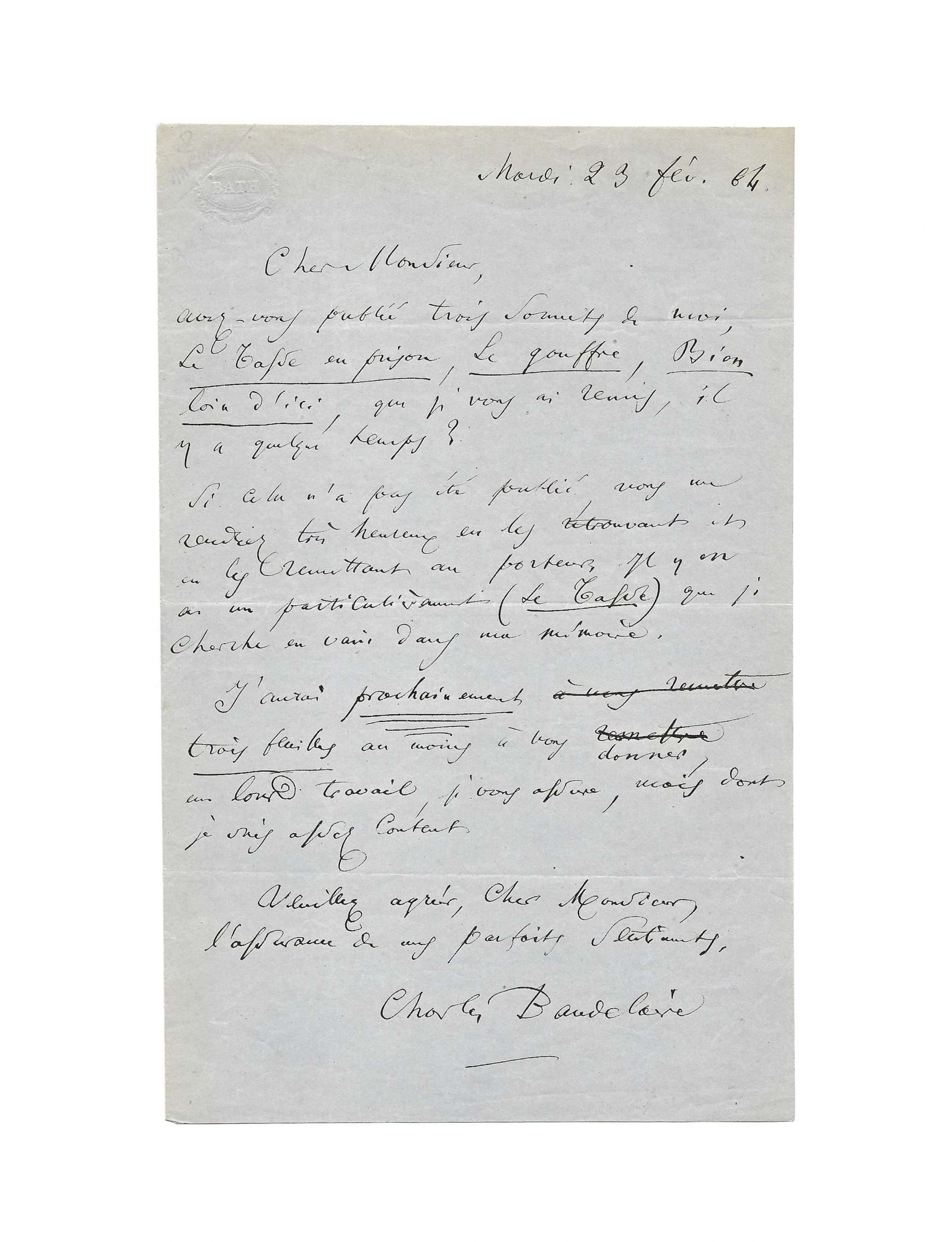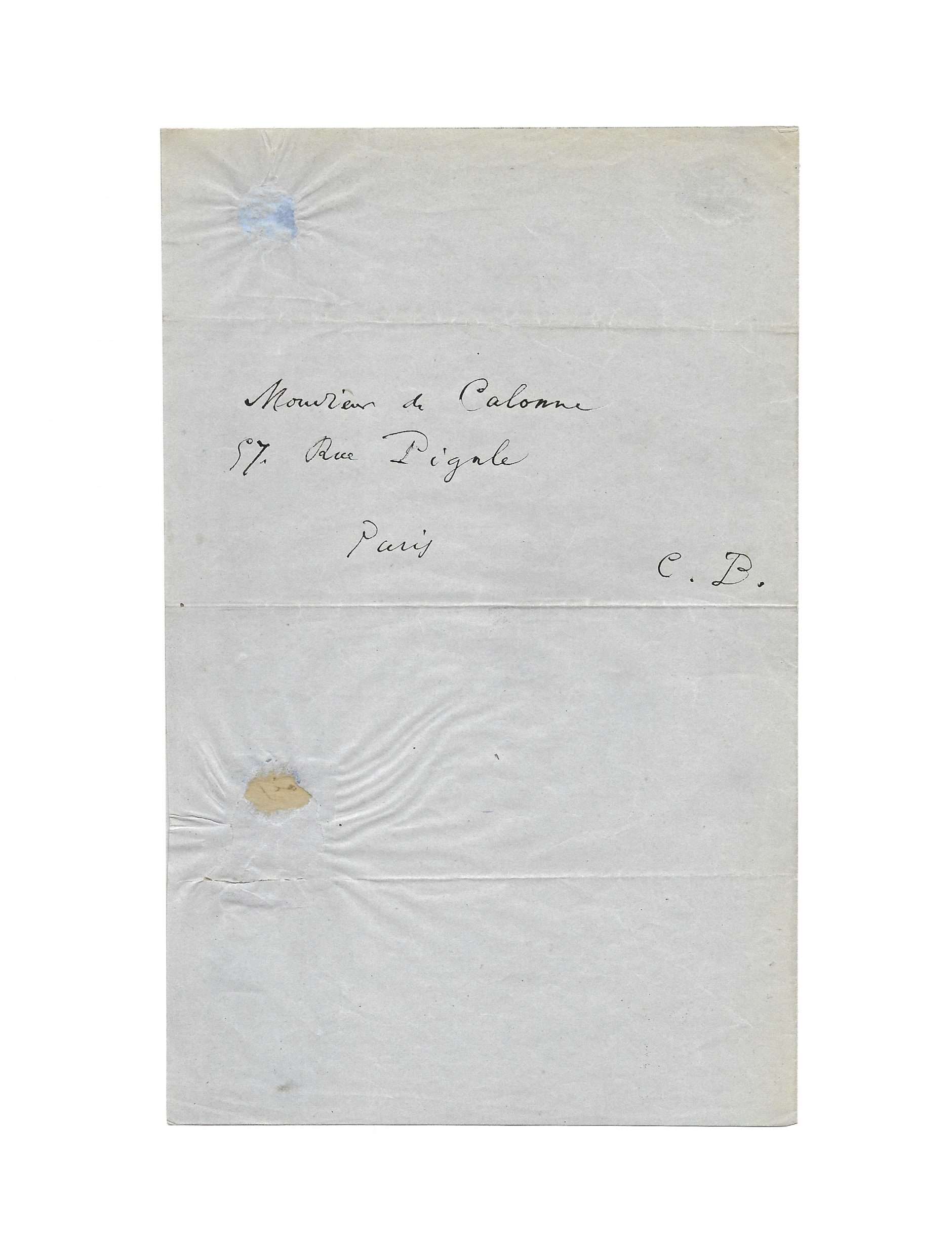BAUDELAIRE, Charles (1821-1867)
Autograph letter signed « Charles Baudelaire » to Alphonse de Calonne
[Paris], 23rd February [18]64, 1 p. in-8° on blue paper
« A heavy work, I assure you, but of which I am quite happy »
Fact sheet
BAUDELAIRE, Charles (1821-1867)
Autograph letter signed « Charles Baudelaire » to Alphonse de Calonne
[Paris], 23rd February [18]64, 1 p. in-8° on blue paper, “BATH” embossed on top left corner
Autograph address on verso, signed « C.B. »
Old and discreet repair with tape on second folio, usual fold marks
Baudelaire asks Alphonse de Calonne to return the manuscripts of three sonnets and announces his forthcoming sending of prose poems, which would form Le Spleen de Paris
« Cher Monsieur,
Avez-vous publié trois sonnets de moi, Le Tasse en prison, Le gouffre, Bien loin d’ici, que je vous ai remis, il y a quelques temps ?
Si cela n’a pas été publié, vous me rendriez très heureux en les retrouvant et en les remettant au porteur. Il y en a un particulièrement (Le Tasse) que je cherche en vain da ma mémoire.
J’aurais prochainement trois feuilles au moins à vous donner ; un lourd travail, je vous assure, mais dont je suis assez content.
Veuillez agréer, cher Monsieur, l’assurance de mes parfaits sentiments.
Charles Baudelaire. »
“Sur Le Tasse en prison d’Eugène Delacroix” was composed in 1844 (after a note by Albert de La Fizelière, the poet’s first biographer, in the upper margin of the manuscript and of which he is the holder at that time). At the end of 1863, Baudelaire had a copy sent by La Fizelière in the form of a letter to Alphonse de Calonne of the Revue contemporaine, but the latter never published it. The day before our letter, on February 22, Baudelaire asked La Fizelière to send him another copy because the poet wanted to have it published by Albert de Collignon in the Revue nouvelle, this time with more success because the publication will take place on March 1st. The same sonnet was later published in Les Epaves, a section added to Les Fleurs du Mal in 1866.
In these verses, Baudelaire seems to refer to his own physical and mental decay, embodied in the Torquato Tasso dans L’asile des fous (1839) by painter Eugène Delacroix. This sonnet also proves the poet’s deep (and one-sided) admiration for the painter in 1843-1844.
“Le Gouffre” was first published in the magazine L’Artiste on 1 March, then in the Revue nouvelle, exactly two years later, and finally in Le Parnasse contemporain on 31 March 1866. The poet’s voice becomes aware of death, generating distressing or even neurotic situations.
“Bien loin d’ici” was published in the Revue nouvelle and then in Le Parnasse contemporain on the same dates as “Le Gouffre”, but also a week before in another journal, on February 23rd. This proves once more that Baudelaire was approaching various publishers simultaneously. In this poem, he takes up topos from the Les Fleurs du Mal such as exoticism and sensual woman.
With regard to the “heavy work … of which [Baudelaire is] quite happy“, it is in all likelihood the Petits Poèmes en prose, a collection also known under the title of the Spleen of Paris (1857-1864). When we know the perpetual relentlessness of the poet to achieve perfection, such a statement may seem paradoxical.
Alphonse de Calonne, founder and director of La Revue contemporaine, never published the three sonnets mentioned by Baudelaire. They appear in Michel Levy’s posthumous edition of the Fleurs du Mal of 1868, section “Spleen et idéal”, under the numbers CI, CII and XCIX – according to the order of mention in the letter.
Provenance:
Collection Minnoret-Rochambeau, Drouot, 20-21 avril 1948, n°14
Bibliography:
Correspondance, t. II, éd. Claude Pichois, Pléiade, p. 348-349



